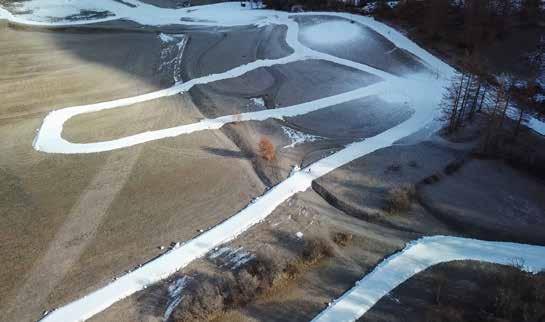3 minute read
ARTIFICIAL SNOW – IT’S THERMODYNAMICS!
Cold air and water are the two ingredients required to make artificial snow. There is no chemistry and no magic product. By spraying droplets of water under pressure in cold air using snow guns, they freeze and transform into ice crystals, which, when the snow thaws, are returned to the environment. New technologies have enabled the starting temperature of snow guns to be decreased, making snow production possible at a positive isotherm, in favourable weather conditions. Due to the low drop height of artificial snow, (from snow guns or lances to the ground), the snow produced has a crystal structure which is slightly different from that of natural snow, and smaller snowflakes. There are no other differences in the spot the difference game.
ALPE D’HUEZ OPTS FOR HYDROGEN
To move towards carbon neutrality, in the winter of 22/23, Alpe d’Huez, one of the resorts operated by the SATA Group, tested a prototype hydrogen snow groomer from a retrofit of a combustion-powered snow groomer. The development and fine-tuning phase will continue during the winter of 2023-2024. SATA Group has already ordered the retrofit of five snow groomers and three hydrogen buses from GCK (Green Corp Konnection).

Snow production: what investment, what reliability?

In terms of investment, the snow machine model variable should be considered. At TechnoAlpin, the TR10, boasting the greatest snow-making capacity on the market, produces around 10 trucks of snow per hour in favourable weather conditions. The automated TR10 fan gun costs the equivalent of a mid-range estate car, while a lance represents an investment of a third of this amount. The service life of the equipment spans several decades. Today, thanks to smart management systems built into the machines, modern automatic snow guns require up to 30% less energy than manual systems. As for water: 1 m3 of water can produce on average 2.5 m3 of snow, considering that you need 1,000 m3 of water to cover a one-hectare slope (approx. 30 cm snow depth).
MOUNTAIN INNOVATIONS: CURRENT AND UPCOMING INNOVATIONS
RESORT MOBILITY – THE MOVE VALLEY LIFTS IN THE FRENCH ALPS
Snow Farming The Example Of Banff Sunshine In Canada
In Banff Sunshine in Alberta, snow farming has been practiced since the mid-seventies. The resort installs kilometres of fence posts above the treeline to capture large quantities of windblown snow. If not, it would be lost or spread out too randomly. When the slopes lack snow, staff spread this natural supply over specific areas. With restricted access to water, preventing the production of artificial snow, snow farming is a good way of getting the most from natural resources. “We capture Mother Nature’s snowfall”, explains Ian Curran, Director of Mountain Operations at Banff Sunshine. “We use available resources and we optimise the conditions created by the weather”.
While the Funiflaine (Magland/Flaine) was axed, other valley lift projects are in the pipeline. In the Mont-Blanc area, the Saint-Gervais/Le Fayet project, with an estimated cost of 14 million euros, should see works begin in spring 2023. In the Tarentaise Valley, the Bozel/Courchevel link is aiming for commissioning by 2024. For the time being, the proposal by the Société des 3 Vallées, the only operator to have answered the call for tender, is under consideration. In Oisans, the Bourg d’Oisans/Huez project, with an estimated cost of 40 million euros, is also in the pipeline, with commissioning planned for the winter season 24/25. The following projects are still in the study phase: Aime/La Plagne, Bourg-Saint-Maurice/La Rosière and Chamrousse Le Recoin/Roche Béranger. Finally, other projects have been examined, and are at various stages of assessment: the link between Thônes and La Clusaz, between Saint-Michel-de-Maurienne, Valloire or Valmeinier in the Northern Alps, the connection between Guillestre and Risoul and between Barcelonnette and Le Sauze in the Southern Alps.
… AND ABROAD
- More than 300 links in Switzerland
- Austria: the Vorarlberg Wälderbahn Dornbirn Lichtenstein community – a 2 site project developer – the Penkenbahn in Mayrhofen, the 3S Eisgrat de Stubaier Gletscher, etc.

- Italy: in Bolzano the Colle cable-car (Kohlerer Bahn), the Renon (Rittner Seilbahn) cable-car and the San Genesio Atesino (Jenesien-Seilbahn) cable-car
- China, Vietnam, Peru, Chile: lift installations (valley/ city/mountains) for accessing tourist attractions
5,000 m3
THE YEAR THE SNOW-FARMING TECHNIQUE WAS FIRST USED IN FRANCE, AT TUFFES STADIUM IN PRÉMANON (JURA).
WE HEAR FROM
Léo Guilbert, Director of Nordic France, the French National Manager of cross-country ski areas.
“Snow farming is a kind of recycling if you will. Artificial snow can be stored better because it is denser and is more resistant to climatic variations”.
SNOW FARMING: WHAT’S THE PROBLEM?

In concrete terms, snow farming means keeping artificial or natural snow from one winter to the next, by storing it as large mounds, protected from the spring thaw and the summer heat by 50 centimetres of wood shavings. At the end of the autumn, the wood shavings are removed from the snow (and kept to be used again) which is then de-compacted and spread out across the slopes. In the Glières Nordic ski area, the technique enables the season to open early. Les Confins-La Clusaz, les Saisies, Bessans (11,000 m³ stored during the 2021/2022 season) and Grand-Bornand all also use the technique.
So, what’s the controversy over? The use of water for making artificial snow, as a complement to natural snow, which is then snow farmed. This controversy struck Grand-Bornand in December 2022, when 12,000 m3 of snow stored at a higher altitude site was transported by truck to the Sylvie Becaert Stadium, to prepare the slopes for the Biathlon World Cup competitions. Detractors questioned the prioritisation of water uses rather than the process of storing snow in itself.











